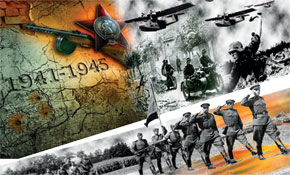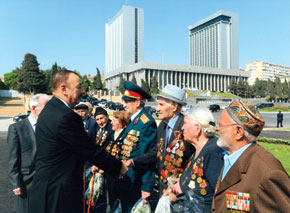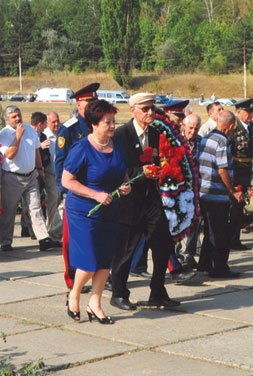 Thousands of Azerbaijanis left for the front in the first years of the Second World War. There were five divisions of their compatriots to join and they displayed great heroism in the fight against fascism. One of the best-known of these divisions was the 416. Our interviewee is Amirali Amiraliyev, Chairman of the Board of Veterans of Rifle Division 416, a member of the Presidium and Plenum of the Council of Veterans.
Thousands of Azerbaijanis left for the front in the first years of the Second World War. There were five divisions of their compatriots to join and they displayed great heroism in the fight against fascism. One of the best-known of these divisions was the 416. Our interviewee is Amirali Amiraliyev, Chairman of the Board of Veterans of Rifle Division 416, a member of the Presidium and Plenum of the Council of Veterans.How do you remember those days?
I was still at school when the war began. Many of us didn’t really understand what was happening. The number of men in the village had gradually diminished; almost all had gone to the front. We children faced great difficulties. Sacrificing our childhood, we had to act like adults. It seems that children grow up quickly in wartime. And then one day, early in 1942, we were told that we were being sent to the front. Graduating students would take their final exams early. It was all explained and in March, during the Novruz holiday, we left for the war. To tell the truth, I wasn’t even 18 then. But nobody was concerned about that, so I was recruited to Azerbaijani Rifle Division 416.
The division mainly covered the Shirvan area. Its headquarters were located in school No 2, in the town of Ujar. The different companies of the division did their military training in Ujar, Goychay, Aghdash, Ali Bayramli (currently Shirvan) and Shamkir.
Division 416 helped to defend the Caucasus in the north of Dagestan, along the banks of the Sulak River, in May 1942. There were 12,000 fighters, 11,050 of them Azerbaijani. A year and five months after their entry into WWII, National Rifle Division 416 was ready to see action. It took part in a battle at Mozdok in November 1942, where we came face to face with Hitler’s troops. There was very heavy fighting. The Germans had all the advantages but we did not take a backwards step.
 President Ilham Aliyev congratulates war veterans on Victory Day, 9 May. Amirali Amiraliyev is 3rd from the right
President Ilham Aliyev congratulates war veterans on Victory Day, 9 May. Amirali Amiraliyev is 3rd from the rightWhat were your duties during those fierce battles?
I was a machine gunner. My young friends were dying in front of my eyes. Imagine that the Earth was joined to the sky; it was impossible to know who was where. We were deafened by the noise of gunfire, cannon and cries from the wounded; it was impossible to distinguish anything or anyone. There was nobody to carry the wounded back. Bodies were piled against each another. Many of the soldiers made barricades from the bodies and fought that way. Then a shell fell near us. I felt my arms go weak. A piece of shrapnel had torn into my right leg. The pain was unbearable. Nobody could help me out of the battle. Besides, we didn’t even know which direction we had come from. Later I realized we had moved further ahead and we were almost surrounded by the enemy.
Now 90 years old, Mr. Amiraliyev relives those terrifying times when his life hung in the balance:
A soldier named Pasha was carrying munitions on a cart. He helped me onto the cart and laid me down. He started back. Along the way, we saw German soldiers at the side of the road. Pasha asked me what he should do. I said that we had to warn the commander. He turned the cart round and whipped the horse along the bumpy road. We were under intensive fire. The bullets broke through the wooden sides of the cart. Fortunately, they didn’t hit me or Pasha or the horse!
After warning the commander, I was put down at the side of the road where there was some traffic. I couldn’t walk. Don’t think that the commander did not care about me. In those circumstances they couldn’t ask a fighter to help me. People were dying and there was an endless stream coming from the rear to take their places. I lost consciousness several times. But the will to live is very strong. I gathered my strength and reached the edge of the road. Suddenly I saw friends from my village on their way to join the battle. Seeing me like that, they cried. What could they do? They couldn’t help me; there was such strict discipline! They had to replace those who had died or were injured on the front line. The cars going back were moving very fast, without stopping. Crawling on my hands and knees, I lay down in the middle of the road and a car on the way back for weapons and ammunitions stopped. They picked me up and hurriedly threw me into the car. When I opened my eyes I found myself surrounded by people wearing white gowns. Later I was sent to a hospital in Baku.
 Amirali Amiraliyev in Taganrog at a monument erected in honor of the 416th Taganrog Azerbaijan Divisions
Amirali Amiraliyev in Taganrog at a monument erected in honor of the 416th Taganrog Azerbaijan DivisionsWas your wound very serious?
My leg was injured and it required four months of treatment. I was rewarded with a medal ‘For Bravery’ for the courage I had shown in the battle. Even after treatment my wounds were not fully healed, but I volunteered for the front lines anyway. I was sent to the 18th Army, to Novorossiysk. The city was surrounded by the Germans. There were fierce battles and in one of them – on 28 October 1943 – I was seriously injured for the second time. The consulting physicians had to make a decision. I was declared unfit for military service in the army and I was demobilized.
How were the other Azerbaijani divisions doing at the front?
As you know, Nazi Germany declared war on the Soviet Union. Under Operation Barbarossa they planned to reach the Caucasus within three to five months, to capture Baku, then to occupy Iran, Iraq, Egypt and India. But together with Rifle Division 416, the Azerbaijani divisions 77, 223, 396 and 402 helped to spoil Hitler’s plans. The main reason for the success gained during the war was that the Supreme Commander-in-Chief had decreed the establishment of national divisions and local self-defence forces to oppose the enemy’s occupying forces.
When was Rifle Division 416 named the Taganrog Division?
On 30 August 1943, Joseph Stalin ordered that Rifle Divisions 130 and 416 were to be named the Taganrog Divisions, then, as part of the 5th Shock Army, 416 fought in battles for the liberation of Ukraine from 30 August 1943 to 25 April 1944. The division had special duties in the liberation of cities like Mariupol, Militopol, Nikolayev and Odessa. In the 10 months it fought as a division it liberated the whole North Caucasus from the enemy. On 30 August 1943 it displayed particular bravery during the liberation of the city of Taganrog, which was of great strategic importance to Hitler’s military. During the winter months of 1943, Division 416 liberated the railway stations of the North Caucasus: Zolotoryov, Georgiyevskaya, Sovietskaya, and towns like Stavropol, Armavir and the shores of the Azov Sea. 2,115 soldiers and officers fought heroically in those battles. They were awarded many orders and medals. Machine-gunner Aghashirin Jafarov was declared a Hero of the Soviet Union after destroying an enemy force of 250 men near Militopol. Let me also mention national leader Heydar Aliyev’s initiative to preserve the memory of soldiers and officers who lost their lives, as well as those who survived the battles. In 1980, a magnificent memorial complex was constructed in the Taganrog suburbs to commemorate the heroism of those Azerbaijani soldiers.
Where did the division finish the war?
The division took part in the liberation of Moldova and Poland’s capital, Warsaw, from 1944-1945. Delivering lethal blows to the enemy, the regiments of Rifle Division 416 entered Berlin on 27 April 1945. The soldiers of Regiment 1373, headed by General H. Heybatov, raised the flag of victory on the Brandenburg Gate on 2 May. Rifle Division 416 finished the war with honour.


